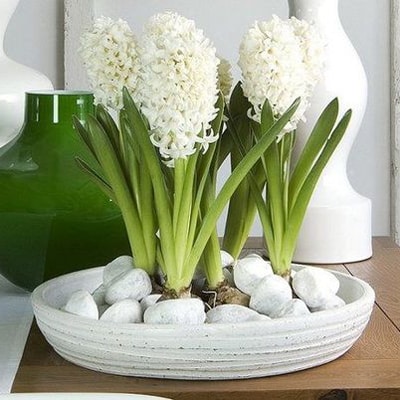Do you have bulbs leftover from this fall, or ones you forgot to plant outside this year (oops!)? Bring a little bloom into your home this winter!
Most spring flowering bulbs can be forced to bloom early by manipulating their normal life cycle. Bulbs are dormant in summer and, normally, only start to develop roots when the soil temperature drops. Forced bulbs need a certain period of cool temperatures to trick them into thinking that the winter has already passed and it’s okay to bloom indoors.
Choose some Bulbs: Select a single bulb variety, or create a bouquet with bulbs of similar bloom periods, or extend the show by choosing bulbs with varied bloom times.
Choose a container: Select a container, with drainage holes, that’s deep enough to hold the bulb plus a 2-3” layer of soil below the bulb and 1” layer of soil above the bulb.
Plant the bulbs: Use a soil mix that drains well and does not include peat moss, which can hold too much water. Look for bagged mixes that contain soil, sphagnum moss, and perlite. Add at least 2” of soil to your container and tamp down. Push the bulbs enough to settle into the soil with points facing upwards. Leave approximately ½” between bulbs. Orienting tulip bulbs with their flat side facing the outside of the container helps to balance stems and leaves throughout the pot.
Chilling period: All but Paperwhites require a certain period of time in temperatures between 32-40 degrees Fahrenheit. Water the containers and place them in an unheated space in garage, basement or refrigerator (not with produce). Check soil moisture regularly and do not allow soil to dry out. When watering, add water to the soil surface and allow it to drain completely through and out of the bottom of the pot to avoid rot.
Some specific bulb chilling requirements:
Bulbs / Weeks of Cold
Crocus / 14-15
Daffodil / 15-17
Muscari – Grape Hyacinth / 13-16
Hyacinth / 10-14
Iris reticulata – Dwarf Iris / 12-15
Tulip / 14-20
Forcing: Once the chilling process is completed and the bulbs start to push through the surface, bring your bulbs into cool but sunny space. Slowly transition them into an area that is about 65 degrees F for blooming.
After-Bloom Care: For the most part, I compost the bulbs once they have stopped flowering. If you want to plant the bulbs out in your garden, fertilize them in the container with a water soluble fertilizer and allow the foliage to die back naturally. Once the foliage has dried, you can plant the bulbs in the garden or brush off any soil and store them in a cool, dry place to plant the following fall.








